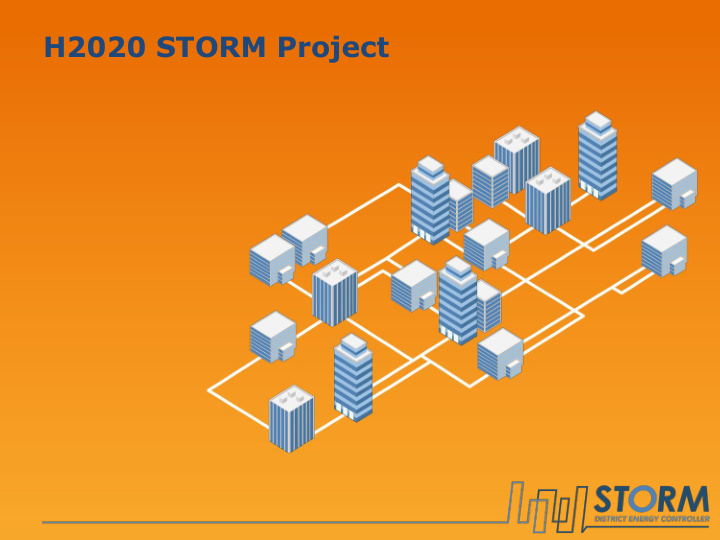



H2020 STORM Project Funded by the H2020 Programme of the EU n Grant Agreement #649743
The context: 4 th generation DHC Decarbonising our energy system by making it more efficient & integrating more renewables 4th generation DHC vs. 3 rd generation Need for flexible solutions Uncontrollable production sources with • fluctuating input Funded by the H2020 Programme of the EU n Grant Agreement #649743
The challenge for 4 th generation DHC ▪ DHC networks are demand driven, not production driven Demand Production How to make a network follow these fluctuating production profiles then? Funded by the H2020 Programme of the EU n Grant Agreement #649743
The solution to 4th generation DHC Solution 1: Influence the demand. Then, Solution 2: Decouple demand and production will follow. production. Demand Production Both solutions can be achieved by a smart controller that makes optimal use of the flexibility in the network. Funded by the H2020 Programme of the EU n Grant Agreement #649743
The solution to 4th generation DHC ‘Natural’ flexibility in DHC networks 1.Thermal mass of buildings 2.Water in network pipes ‘Artificial’ flexibility in DHC networks 3. Physical thermal storage buffers The flexibility is there! A intelligent network controller can ‘activate’ this flexibility the STORM project Funded by the H2020 Programme of the EU n Grant Agreement #649743
The STORM project STORM = ‘ S elf-organising T hermal O perational R esource M anagement’ Aim: Develop & demonstrate a generic intelligent DHC network controller ▪ based on self-learning optimization techniques Start date: 1 st of March 2015, 42 months ▪ Funded by the H2020 Programme of the EU n Grant Agreement #649743
What are the objectives of the project ? To develop a generic controller for district heating and cooling • (DHC) networks To demonstrate the developed generic controller in two existing • DHC networks. … and to quantify the benefits, ▪ develop innovative business models, ▪ increase the awareness and ▪ ensure market-uptake ▪ 7 Funded by the H2020 Programme of the EU n Grant Agreement #649743
The generic features ▪ Generic = able to deal with a wide range of networks ▪ Guaranteed by a number of features: 1. Add-on to existing network controllers and SCADA-systems 2. Open-source communication protocols 3. Self-learning algorithms to prevent model tuning 4. Multiple thermal storage concepts 5. Multiple control strategies 3 rd and 4 th generation demonstration sites 6. Funded by the H2020 Programme of the EU n Grant Agreement #649743
Multiple control strategies For typical networks with a smaller sustainable energy source (biomass boiler, heat pump) and a larger fossil backup Elimination of fossil fuel. For networks coupled to the electric grid by heat pumps/CHPs Switching the devices at interesting power price. For more sophisticated networks: balance supply and demand of heat/cold in a cluster increased efficiency. Funded by the H2020 Programme of the EU n Grant Agreement #649743
The demonstration sites Rottne, Växjö, Sweden A very typical 3 rd generation network ▪ 175 consumers ▪ 2 wood chips boiler (1.5 MW + 1.2 MW) + bio fuel boiler (3MW) (backup) ▪ Design temperature 90-60 ° C ▪ Objective: eliminate the operation of the expensive peak fuel boiler Funded by the H2020 Programme of the EU n Grant Agreement #649743
The demonstration sites Heerlen, the Netherlands A highly innovative 4th generation network Very low temperatures (‘hot’ pipe ▪ 28 ° C – ‘cold’ pipe 16° C) ▪ Heating & cooling ▪ Coupled to underground mine water storage ▪ Objective: balancing of heat/cold producers and consumers Funded by the H2020 Programme of the EU n Grant Agreement #649743
Work packages 2 versions of the controller: v1 will be tested in during the winter 2016- 2017 v2 will be tested in during the winter 2017- 2018 Funded by the H2020 Programme of the EU n Grant Agreement #649743
Implementation of the controller algorithm 3 modules Forecaster “What will be the energy consumption of the network for the next 24h?” – i.e. reference consumption Planner “Given the control objectives (peak shaving/elec. market interaction/cell balancing), which optimal cluster consumption profile can be achieved, taking into account this forecast?” Dispatcher-Tracker “Which individual control signals are necessary to follow/track the optimal consumption profile?” Funded by the H2020 Programme of the EU n Grant Agreement #649743
Status Almost halfway! January to March 2016: Algorithms developed, implemented & tested in Rottne This month, October 2016: start implementation in Heerlen network Funded by the H2020 Programme of the EU n Grant Agreement #649743
THANK YOU! info@storm-dhc.eu http://storm-dhc.eu Funded by the European Union's H2020 Programme under grant agreement n°649743 Funded by the H2020 Programme of the EU n Grant Agreement #649743
Recommend
More recommend